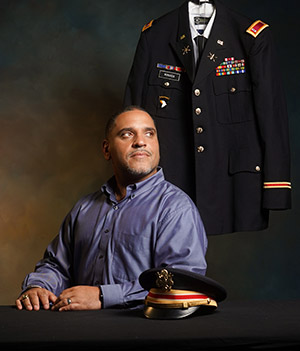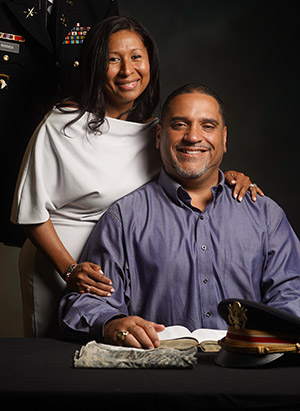A Huntsville Engineer’s Commitment to the Equipment that Brought him Home Safe from Iraq
By Rafael Miranda
I was 38 years old and an U.S. Army chief warrant officer deployed to northern Iraq when I heard the siren that saved my life.
In 2016, five months into what would be my final tour, my team jumped to Qayyaarah, Iraq, a town about 35 miles south of Mosul. The site was obliterated, reduced to rubble. Upon arrival, we had engineers clear things so we could establish a footprint. A counter-rocket artillery and mortar (C-RAM) system was set up, including the RAM Warn equipment that sounds the alarm when incoming threats are detected.

There was a Q-53 team there. Q-53 is a fire-finder radar that sends information to Northrop Grumman’s Forward Area Air Defense command and control (FAAD C2) system, which confirms the threat and predicts points of origin or impact during inbound attacks — it tells where a rocket is coming from and where it will hit so RAM Warn can sound the alarm. One afternoon, another officer and I headed out in a vehicle to connect the Q-53 radar with the RAM Warn sensor kit. I had a lot of thoughts in my head, all focused on our goal — get the configurations right, record the direction the radar is facing, make sure the IP addresses are set. And then I heard the siren.
We were under fire.
My Roots
Something you should know about me is that I’m someone who loves his family and God above everything. Just like my family and friends were waiting for me to return home, there are many people waiting at home for their soldiers to return today. I joined the U.S. Army in 2005. At the time of the Sept. 11 attacks, I was a Radio Shack manager in Hoboken, New Jersey, right across the Pulaski Skyway, the connecting bridge to Manhattan. Living in that environment, directly facing the chaos, that’s what drew me to join the military.
It took a while because I had to get fit first. I lost 79 pounds before basic training in Fort Sill, Oklahoma. Most folks were 17, 18, 19 years old, and there I was at 27, second-oldest in the group, trying to keep up. It was challenging, but motivating. After advanced individual training at Fort Bliss, Texas, I did three Middle East tours: Iraq in 2008, Afghanistan in 2014 and finally Iraq again in 2016.
That last tour in Iraq, in addition to my trust in God and my loved ones back home praying for my safe return, I remember also having confidence in that Northrop Grumman equipment, C-RAM.
Final Deployment
When that siren went off, adrenaline surged through my body. We immediately pulled behind a protective barrier and took cover. Seconds later, we watched as an incoming rocket hit nearby. Had we not heard the RAM Warn, we would have been too close to the explosion to safely escape, or at least been hit by shrapnel.

I felt a sigh of relief, but then wondered if there were more rockets. Despite feeling disoriented, I felt sure that if there was more incoming, C-RAM would detect it and warn us with time to take cover.
Ultimately, the mission in Qayyaarah proved to be a success. We were able to support the push north to Mosul with the Iraqi armed forces.
Support Off the Battlefield
Soon, my personal mission changed.
During my time overseas, I sustained a lot of injuries from wear and tear. I started feeling pain throughout my body and knew I couldn’t continue helping warfighters on the ground. But the fight wasn’t over. That’s what brought me to Northrop Grumman almost four years ago.
Today, I work on C-RAM as a test engineer in Huntsville, Alabama. When the equipment comes in from the field, I verify that it’s configured correctly and fully functional. I make sure any integration or updates needed are done correctly. That’s a huge responsibility. I was once the warfighter using that equipment, and it worked to protect me — it helped keep me alive while deployed. I owe it to the next warfighter — and their family — to do my job well.
Return to the Life at Northrop Grumman home page.
Search for jobs as a test engineer, or jobs in Huntsville, or all jobs.